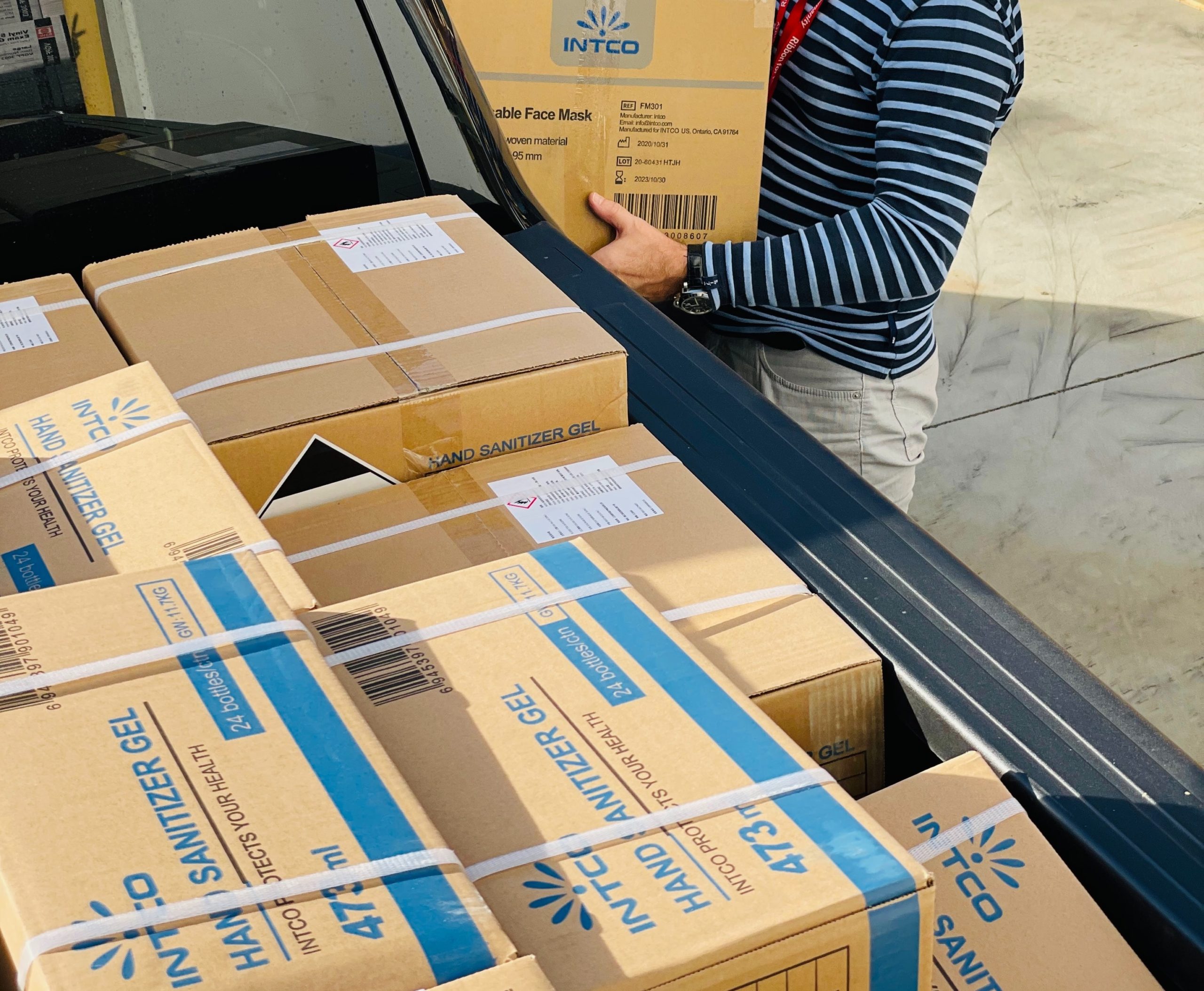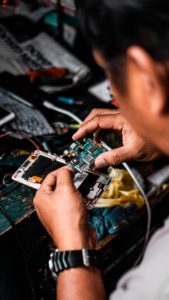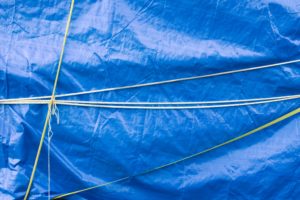How does procurement impact climate?
Procurement can make a real difference in reducing carbon emissions. Greenhouse gas emissions of goods are associated with the extraction of raw materials, the production and processing/manufacturing stage, packaging, storage and transport. Emissions from purchased services are related to the activities of the supplier to provide the services (energy-use in the supplier’s office, travel, etc.). For organisations in the aid sector, procurement can account for up to 70% of their carbon footprint.
What are non-food items and where is the highest impact?
Non-food items comprise products such as bedding and clothes, hygiene products, household equipment, lamps, stoves and heaters, and in the context of relief operations, tarpaulins, construction and shelter material, to name a few. The highest carbon impact of non-food items occurs through the use of raw materials and during the manufacturing stage. These articles are dominantly produced following the currently prevalent linear economy model: virgin resources are used for their production and the product is disposed of after its lifetime (“take-make-use-trash”). Adopting a circular economy approach by eliminating waste and pollution, circulating products and materials, is one of the key solutions to tackle emissions from non-food items.

How can we act?
There are two key strategies in reducing the carbon impact of non-food items:
- Firstly, opting for used, repaired or refurbished items, if possible, along with choosing repairable products.
- Secondly, the choice of material plays a major role regarding the carbon and environmental impact of a product, for example, using alternative materials with a lower environmental footprint or recycled material.
Solutions for non-food items that concern the type of material are relatively easy to implement. Potential implications on cost will depend on the chosen material. When it comes to moving partly to buying used, repaired or remanufactured items, a broader shift in the way these products are bought, managed and maintained is required. It is expected that the availability of such items will increase with the move towards a circular economy, driven by legislation and business model innovation. Potentially higher prices for alternative materials could, in the mid to long-term, be outweighed by cost savings from buying used, repaired or remanufactured items.
Points of attention
-
Points of attention
As with all solutions related to procurement, early buy-in and, eventually, training of procurement leadership and staff is crucial. Consulting early in the process with staff on the ground regarding the practical implications of envisaged alternatives will be a key success factor.
It is important to keep in mind broader environmental impacts when choosing alternative materials. For example, conventional cotton has a relatively low carbon impact, but a large footprint when it comes to water, pesticides, fertiliser and land use.
Considering also the use-phase of the product gives a better view of the impacts. For example, for cooking stoves, the type of burning material used has an impact on air pollution.
Key solutions
-
#1 Repairable items
Source items that are repairable and put in place local repair solutions to extend the lifetime of products and work towards a circular economy.
-
#2 Source used, repaired, remanufactured items
Favour items that are used, repaired or remanufactured instead of ordering new articles to save cost and resources.
-
#3 Low-carbon materials
Analyse the different material options available and choose low-carbon or more environmentally friendly materials.
-
#4 Recycled materials
Set targets for the incorporation of recycled materials instead of using virgin resources to reduce carbon emissions and limit resource use.
-
#5 Cookstoves
Increasing access to clean cooking stoves and fuels reduces greenhouse gas emissions while creating positive health and wellbeing outcomes for beneficiaries.
-
#6 Mosquito nets
The production and disposal of long-lasting insecticidal nets (LLINs) pose significant environmental and health risks. Solutions exist to reduce the climate and environmental impact of this key item for the international aid sector.
-
#7 Eco-design tarpaulin
ICHC, IFRC and UNHRC have joined forces and produced an eco-design tarpaulin with a reduced footprint.
Success story
Dutch Ministry of Defence – Textile procurement
The Ministry of Defence of the Netherlands explored a more circular approach to textile procurement. Suppliers were asked to submit proposals for towels and overalls that contain at least 10% recycled fibres. In a pilot, 100,000 towels were purchased (containing 36% and 14% recycled post-consumer textiles fibres respectively). The pilot generated estimated savings of 233,000,000 litres of water, 69,000 kg CO2 and 23 MJ of energy. In parallel, a third party was contracted to sort existing items of clothing for reuse and resale. In addition to the environmental benefits, this will result in considerable savings for the Ministry. (4)
Key steps
-
Prioritise
Use information from the carbon footprint to identify and prioritise items with the highest emission share
-
Develop specifications
Outline what alternatives and what type of material should be privileged by buyers. Start with a few items and with “easy-wins”, integrate lessons learned and include more items over time.
-
Perform market analysis
Depending on the potential alternatives identified, perform a market analysis to verify availability of products and suppliers. Review specifications if needed.
-
Set sourcing targets
Develop measurable sourcing targets and integrate them into the performance ranking of buyers.
-
Train staff
Involve and inform personnel involved in procurement early about the climate strategy and updated policies and procedures.
Identify alternatives by using, for example, the 7R approach
Refuse
- Do we source the right quantities?
- Is the item adapted to the local needs and cultural habits of the population? If not, replace it with an appropriate item.
Repair
- Is it possible to repair existing equipment instead of replacing it (e.g. for tarpaulins, shelters, cooking stoves, lamps, etc.)?
- Are the tools and know-how to repair items available locally?
Rethink & Reuse
- Is there a used, repaired, refurbished, alternative available?
- Can we switch from a single-use to a reusable product?
Reduce (the impact of the material)
- Is there an alternative, lower-carbon or more environmentally-friendly material available?
- Is the material recyclable?
- Is there an alternative option with fully biodegradable ingredients available (e.g. for soaps, washing liquid/powder)?
- If the product contains palm oil, can we reduce the percentage and/or use certified palm oil?
Recycle
- Is local recycling infrastructure in place?
- Can we take back the item in areas without a functioning recycling infrastructure?
- Can we lobby local authorities to put in place recycling infrastructure?
Rot/End-of life management
- Is the product reusable, repairable, easy to dissemble?
To solve the greatest threat humanity has faced requires that our species look deeply and critically at the ways we do, well... everything. The good news is that the solutions already exist. Chad Frischmann, Vice President and Research Director, Project Drawdown (5)
Tools and best practices
-
Ellen MacArthur Foundation, Circular Economy Procurement Framework
An online tool to help organisations kickstart circular economy initiatives within their procurement process.
Read here -
Zero Waste Scotland, Procuring for: Repair, Re-use and Remanufacturing, 2016
A comprehensive guide on how to embed a circular approach to procurement, focussing on repair, re-use and remanufacturing. Detailed guidance is provided for the categories of catering, cleaning, construction, electronic equipment, furniture, medical devices, textiles, and vehicles, among others.
Read here -
UNHCR: Operational Strategy for Climate Resilience and Environmental Sustainability 2022 – 2025
An example of how to embed a more circular approach to procurement in strategic objectives.
Read here
To go further
-
Ellen MacArthur Foundation, Completing the Picture. How the Circular Economy tackles Climate Change, 2021
The report highlights the indispensable role that the circular economy plays in tackling the climate crisis.
Read here -
PACE – Platform for Accelerating the Circular Economy
PACE brings together leaders from across business, government and civil society to develop a collective circular economy agenda and drive ambitious action.
Read here -
ICLEI, Sustainable Procurement Platform
The online platform provides up-to-date news, case studies, events, guidance and more on sustainable procurement from across the world. The focus lies on public procurement, but many of the examples and resources are applicable across organisations.
Read here
Download this solution area
-
Non-food items
Download
Sources
Repairable items

Recycled materials

Cookstoves

Mosquito nets

Eco-Design Tarpaulin

(1) Ellen MacArthur Foundation, 2017, The New Plastics Economy: Rethinking the Future of Plastics & Catalysing Action. Read here.
(2) Project Drawdown, Recycling. Read here.
(3) Ellen MacArthur Foundation, A New textile’s economy: Redesigning Fashion’s Future, 2017. Read here.
(4) Procura, Case Study: Procuring Textiles Made From Recycled Fibres, 2018. Read here.
(5) Cited from Ellen MacArthur Foundation, 2021, Completing the Picture. How the Circular Economy tackles Climate Change. Read here.
Cover photo © Heather Ford/Unsplash.
Mosquito nets

Cookstoves

Eco-Design Tarpaulin

Recycled materials

Repairable items

